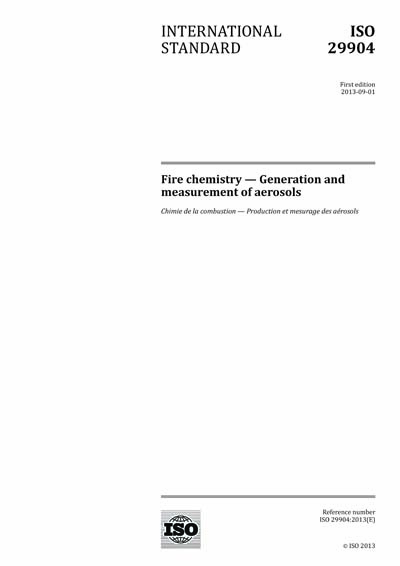Most recent
ISO 29904:2013
Fire chemistry - Generation and measurement of aerosols
ISO 29904:2013 provides a guide to the generation of aerosol particles in fires, defines apparatus and procedures for the sampling and measurement of aerosols, and provides procedures for the interpretation and reporting of the data. It is intended to assist fire test designers and those making measurements at unwanted fires to choose and use appropriate methods for aerosol measurement for differing hazards to people and the environment.
ISO 29904:2013 identifies the scope, applicability, and limitations of each method. The interpretation of the data from these measurements is strongly dependent on the end use of the data.
Fire-generated aerosols may present a direct risk of restricting escape from fire by obscuring an exit route, or they may produce chronic health and environmental hazards from chemical compounds contained in the aerosol (for example, toxic chemicals like polycyclic aromatic hydrocarbons in soot or radionuclides form nuclear plant fires.) Aerosol particles may be inhaled to various depths in the lungs, depending on their size and density, or may be released into the environment and deposited on land and in watercourses.
In particular, it addresses the following aspects of aerosol generation and measurement in fires:
- Adsorbed/dissolved gas or vapour phase species;
- Physical mechanisms involved in the transport of aerosols, dispersal in the fire plume, coagulation/agglomeration leading to variation in particle sizes and fractions, "thermophoresis" (main cause of soot deposition), "diffusiophoresis" and, sedimentation.
- The interactions between gases and vapours and aerosol: adsorption and removal of species from gas phase, transportation of adsorbed gases into the lungs;
- Sampling and measurement methods, including their principles of operation, method description, the data provided, and in each case their scope, field of application, advantages and disadvantages;
- Metrology of the measurement methods, and in the generation of "standard aerosols", and the related uncertainties;
- Physiological and environmental effects of aerosols insofar as these effects can be used to define the measurement method for specific applications; and
- Hazards of carbon particles present in the fire effluent as visible "smoke" through their size, morphology, chemical nature, and the nature of the effluent in which they are (or were) suspended.
ISO 29904:2013 is not oriented toward the aerosols generated from controlled combustion. (e.g. incineration). However, much of the material in ISO 29904:2013 is common to such aerosols.
Content Provider
International Organization for Standardization [iso]






